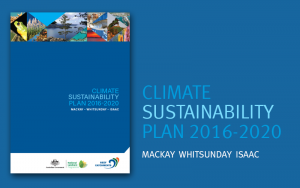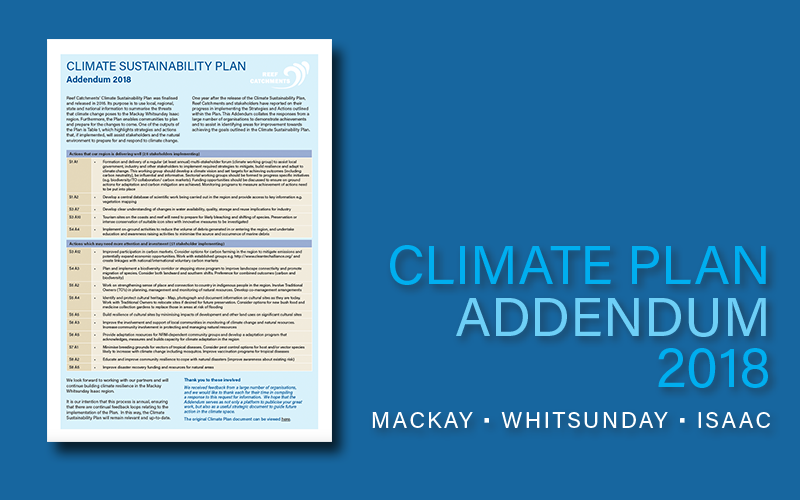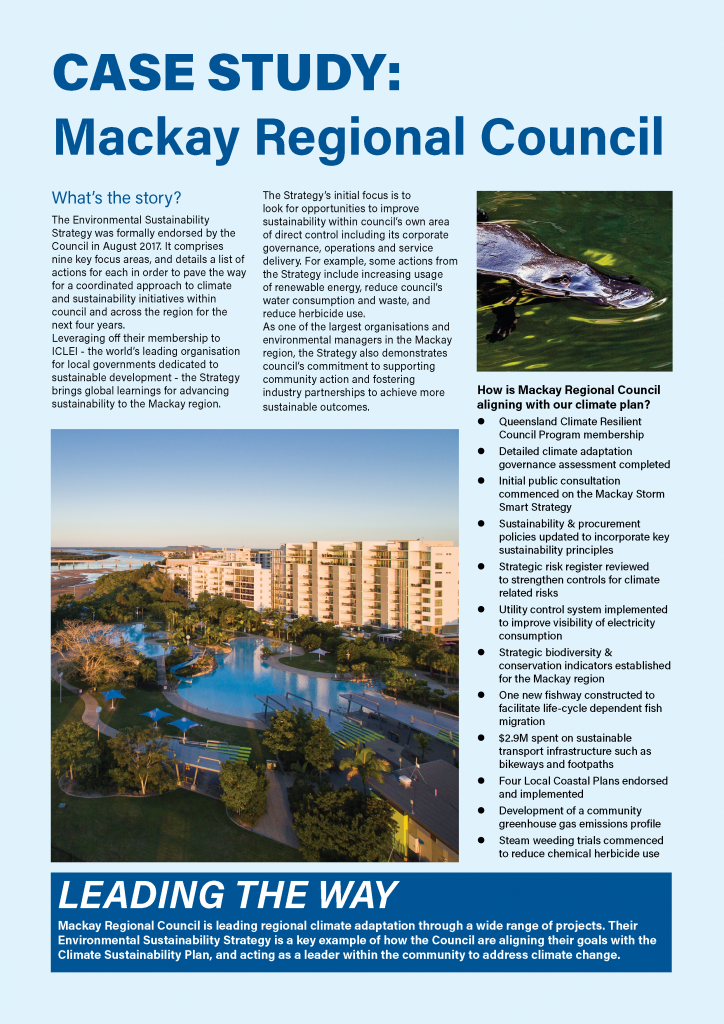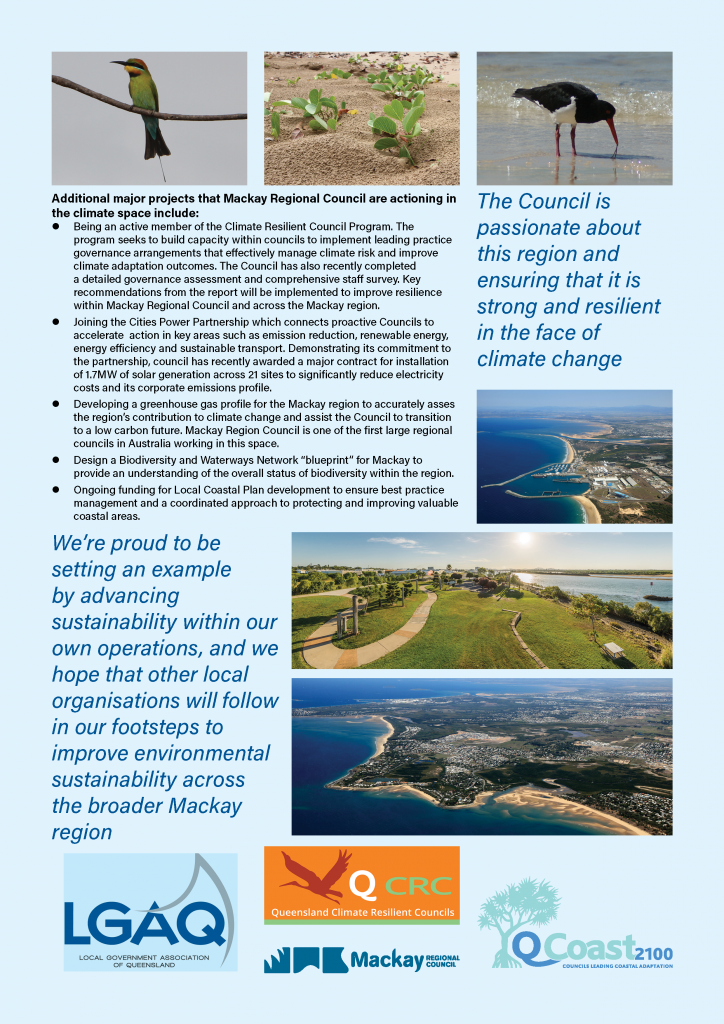 Local climate projections are available for the Mackay, Whitsunday, Isaac region
Local climate projections are available for the Mackay, Whitsunday, Isaac region
The MWI Climate Sustainability Plan 2016-2020 is a highly collaborative plan developed in partnership with the CSIRO and James Cook University, through funding from the Australian Government.
One of the first documents to identify local climate trends, forecasts, and predictions, the Climate Plan is expected to be a critical tool in future regional and local planning. The Plan sets out the most recent, regionally specific projections for rainfall, temperature, sea level rise, and other climatic changes. Importantly, it outlines areas of climate vulnerability, regional priorities in a changing climate, and potential adaptation strategies and actions.
Reef Catchments would like to acknowledge input into the Plan from a wide range of contributors, including community groups, industry, local council, and key stakeholders.
The Plan has been provided to stakeholders around the region, including local councils and government planning departments.
Download a copy of the MWI Climate Sustainability Plan 2016-2020
Please contact Reef Catchments on (07) 4968 4200 if you would like a hardcopy.
Development of the plan was supported through funds from the Australian Government’s NRM Planning for Climate Change fund, and the National Landcare Programme.
 REGIONAL CLIMATE PLAN ADDENDUM 2018
REGIONAL CLIMATE PLAN ADDENDUM 2018
Reef Catchments’ Climate Sustainability Plan was finalised and released in 2016. Its purpose is to use local, regional, state and national information to summarise the threats that climate change poses to the Mackay Whitsunday Isaac region. Furthermore, the Plan enables communities to plan and prepare for the changes to come. One of the outputs of the Plan is Table 1, which highlights strategies and actions that, if implemented, will assist stakeholders and the natural environment to prepare for and respond to climate change.
One year after the release of the Climate Sustainability Plan, Reef Catchments and stakeholders have reported on their progress in implementing the Strategies and Actions outlined within the Plan. This Addendum collates the responses from a large number of organisations to demonstrate achievements and to assist in identifying areas for improvement towards achieving the goals outlined in the Climate Sustainability Plan.
Actions that our region is delivering well (6 or more stakeholders implementing)
| S1 A1 | • Formation and delivery of a regular (at least annual) multi-stakeholder forum (climate working group) to assist local government, industry and other stakeholders to implement required strategies to mitigate, build resilience and adapt to climate change. This working group should develop a climate vision and set targets for achieving outcomes (including carbon neutrality), be influential and informative. Sectorial working groups should be formed to progress specific initiatives (e.g. biodiversity/TO collaboration/ carbon markets). Funding opportunities should be discussed to ensure on ground actions for adaptation and carbon mitigation are achieved. Monitoring programs to measure achievement of actions need to be put into place |
| S1 A2 | • Develop a central database of scientific work being carried out in the region and provide access to key information e.g. vegetation mapping |
| S3 A7 | • Develop clear understanding of changes in water availability, quality, storage and reuse implications for industry |
| S3 A10 | • Tourism sites on the coasts and reef will need to prepare for likely bleaching and shifting of species. Preservation or intense conservation of suitable icon sites with innovative measures to be investigated |
| S4 A4 | • Implement on-ground activities to reduce the volume of debris generated in or entering the region, and undertake education and awareness raising activities to minimise the source and occurrence of marine debris |
Actions which may need more attention and investment (1 or fewer stakeholders implementing)
| S3 A12 | • Improved participation in carbon markets. Consider options for carbon farming in the region to mitigate emissions and potentially expand economic opportunities. Work with established groups e.g. http://www.cleantechalliance.org/ and create linkages with national/international voluntary carbon markets |
| S4 A3 | • Plan and implement a biodiversity corridor or stepping stone program to improve landscape connectivity and promote migration of species. Consider both landward and southern shifts. Preference for combined outcomes (carbon and biodiversity) |
| S5 A2 | • Work on strengthening sense of place and connection to country in indigenous people in the region. Involve Traditional Owners (TO’s) in planning, management and monitoring of natural resources. Develop co-management arrangements |
| S5 A4 | • Identify and protect cultural heritage – Map, photograph and document information on cultural sites as they are today. Work with Traditional Owners to relocate sites if desired for future preservation. Consider options for new bush food and medicine collection gardens to replace those in areas at risk of flooding |
| S5 A5 | • Build resilience of cultural sites by minimising impacts of development and other land uses on significant cultural sites |
| S6 A3 | • Improve the involvement and support of local communities in monitoring of climate change and natural resources. Increase community involvement in protecting and managing natural resources |
| S6 A5 | • Provide adaptation resources for NRM-dependent community groups and develop a adaptation program that acknowledges, measures and builds capacity for climate adaptation in the region |
| S7 A1 | • Minimise breeding grounds for vectors of tropical diseases. Consider pest control options for host and/or vector species likely to increase with climate change including mosquitos. Improve vaccination programs for tropical diseases |
| S8 A2 | • Educate and improve community resilience to cope with natural disasters (improve awareness about existing risk) |
| S8 A5 | • Improve disaster recovery funding and resources for natural areas |
We look forward to working with our partners and will continue building climate resilience in the Mackay Whitsunday Isaac region.
It is our intention that this process is annual, ensuring that there are continual feedback loops relating to the implementation of the Plan. In this way, the Climate Sustainability Plan will remain relevant and up-to-date.
Thank you to those involved
We received feedback from a large number of organisations, and we would like to thank each for their time in compiling a response to this request for information. We hope that the Addendum serves as not only a platform to publicise your great work, but also as a useful strategic document to guide future action in the climate space.
Taking climate action
Here is the full table of actions which shows how our partners have been implementing them during 2017-18.
Further resources
View the original Climate Plan
View the Mackay Regional Council Case Study

